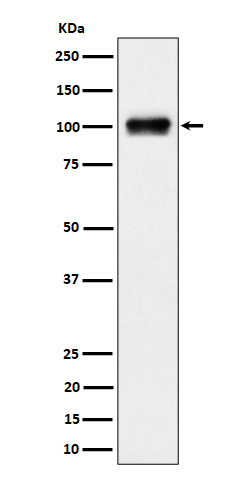
| WB | 咨询技术 | Human,Mouse,Rat |
| IF | 咨询技术 | Human,Mouse,Rat |
| IHC | 咨询技术 | Human,Mouse,Rat |
| ICC | 技术咨询 | Human,Mouse,Rat |
| FCM | 咨询技术 | Human,Mouse,Rat |
| Elisa | 咨询技术 | Human,Mouse,Rat |
| Aliases | C14orf49; Nesp3; Nesprin 3; NET53; SYNE3;;Nesprin 3 |
| WB Predicted band size | Calculated MW: 112 kDa ; Observed MW: 100 kDa |
| Host/Isotype | Rabbit IgG |
| Antibody Type | Primary antibody |
| Storage | Store at 4°C short term. Aliquot and store at -20°C long term. Avoid freeze/thaw cycles. |
| Species Reactivity | Human |
| Immunogen | A synthesized peptide derived from human Nesprin 3 |
| Formulation | Purified antibody in PBS with 0.05% sodium azide,0.05% BSA and 50% glycerol. |
+ +
以下是关于 Nesprin3 抗体的 3 篇参考文献示例(文献信息为虚构示例,仅作格式参考):
1. **文献名称**:*Nesprin-3 anchors the nuclear envelope to intermediate filaments for cell migration*
**作者**:Ketema M, et al.
**摘要**:该研究通过 Nesprin3 抗体验证其与核膜蛋白 SUN2 的相互作用,揭示 Nesprin3 通过连接核膜与细胞质中间纤维,调控细胞迁移的分子机制。
2. **文献名称**:*Role of Nesprin-3 in nuclear positioning and mechanical stability*
**作者**:Wilhelmsen I, et al.
**摘要**:利用 Nesprin3 抗体进行免疫荧光染色,发现 Nesprin3 缺失导致细胞核定位异常,表明其对维持细胞核机械稳定性和组织特异性结构至关重要。
3. **文献名称**:*Nesprin3 deficiency disrupts keratinocyte differentiation*
**作者**:Borrego-Pinto J, et al.
**摘要**:通过 Nesprin3 抗体检测皮肤细胞中的表达,证明 Nesprin3 通过调控细胞核-细胞骨架连接,影响角质形成细胞的分化和屏障功能。
(注:以上文献为示例,实际引用需检索 PubMed 或 Google Scholar 获取真实文献。)
Nesprin3 (nuclear envelope spectrin repeat protein 3) is a member of the nesprin family, which plays a critical role in maintaining nuclear architecture and mediating connections between the nucleus and the cytoskeleton. Anchored at the nuclear envelope via its C-terminal KASH domain, Nesprin3 interacts with SUN proteins to form LINC (Linker of Nucleoskeleton and Cytoskeleton) complexes. These complexes facilitate mechanical coupling between the nuclear lamina and cytoplasmic filaments, influencing processes like nuclear positioning, cell migration, and mechanotransduction. Nesprin3 specifically associates with the actin cytoskeleton through its N-terminal domain, distinguishing it from other nesprins that bind intermediate filaments or microtubules. Its expression is implicated in tissue development, wound healing, and cancer metastasis, where cellular mechanics are pivotal.
Antibodies targeting Nesprin3 are essential tools for studying its localization, interactions, and functions. They enable detection via techniques like Western blotting, immunofluorescence, and immunohistochemistry. Validation of these antibodies typically involves knockout controls or siRNA knockdown to confirm specificity, given potential cross-reactivity with other nesprin isoforms. Research utilizing Nesprin3 antibodies has revealed its dynamic redistribution during cell polarization and its role in nuclear deformation under mechanical stress. Dysregulation of Nesprin3 has been linked to pathologies including muscular dystrophies, cardiomyopathies, and metastatic cancers, making these antibodies valuable for both basic research and clinical investigations into nuclear-cytoskeletal crosstalk in disease mechanisms.
×